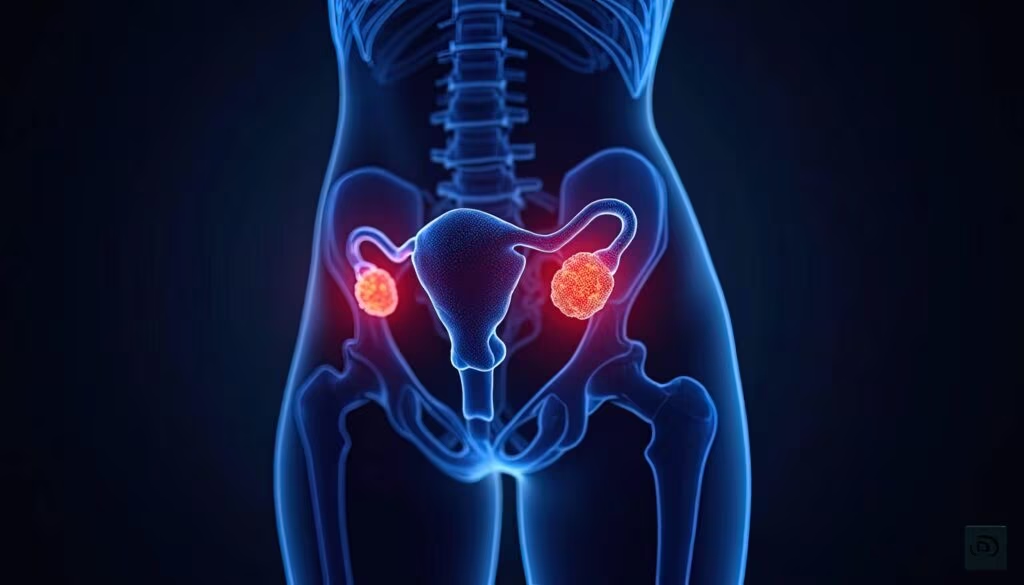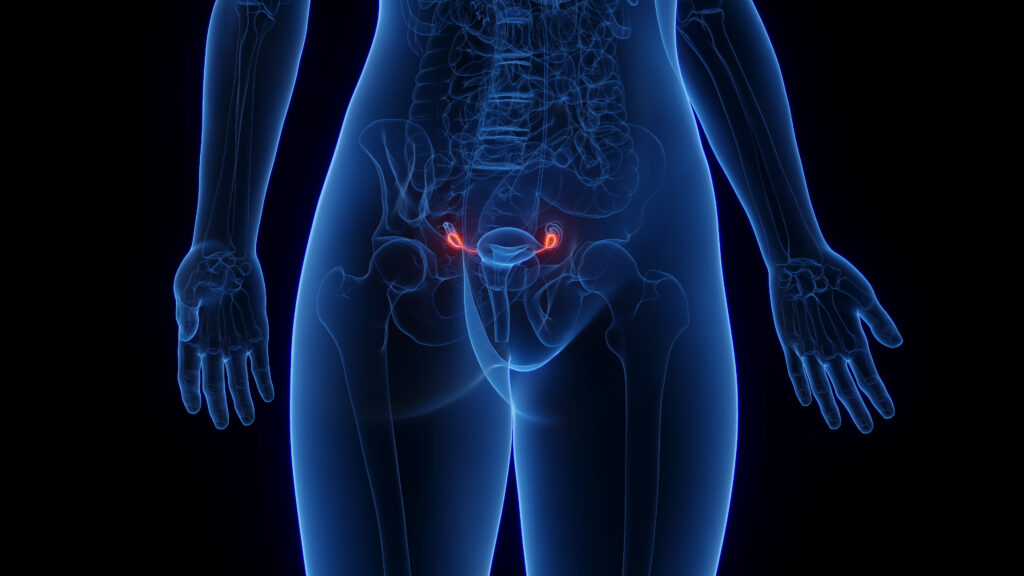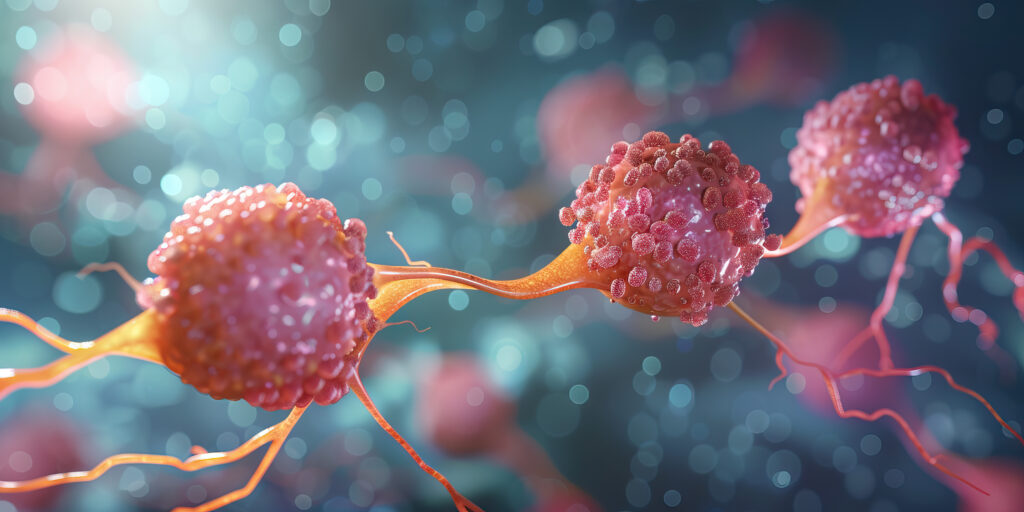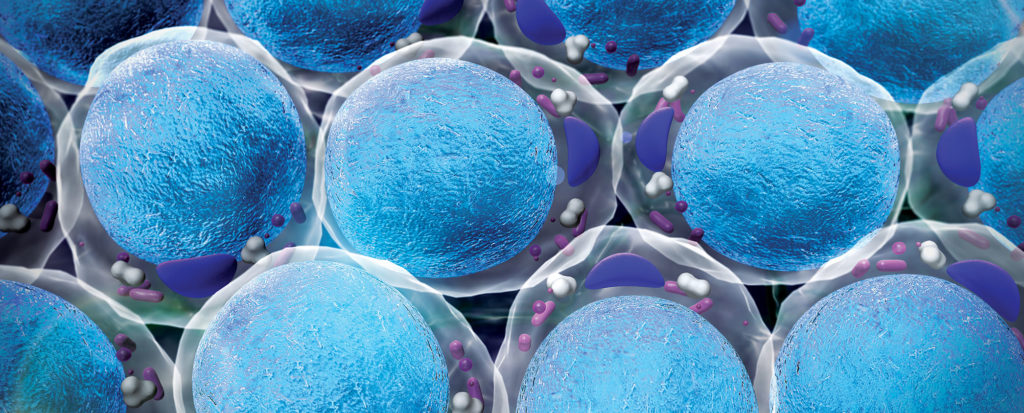There are three gonadotrophic hormones: follicle-stimulating hormone (FSH) and luteinising hormone (LH), produced by the anterior pituitary gland, and human chorionic gonadotrophin (hCG), produced by placental trophoblasts. Besides stimulating gonadal steroidogenesis and gametogenesis, these hormones have stimulatory effects on the proliferation of their target cells. Therefore, it is feasible that gonadotrophins could participate in the initiation or subsequent growth of tumours arising in their target organs.
There are three gonadotrophic hormones: follicle-stimulating hormone (FSH) and luteinising hormone (LH), produced by the anterior pituitary gland, and human chorionic gonadotrophin (hCG), produced by placental trophoblasts. Besides stimulating gonadal steroidogenesis and gametogenesis, these hormones have stimulatory effects on the proliferation of their target cells. Therefore, it is feasible that gonadotrophins could participate in the initiation or subsequent growth of tumours arising in their target organs. Ovarian granulosa and testicular Sertoli cells are the classic target cells for FSH action, and ovarian theca, granulosa and luteal cells and testicular Leydig cells those for LH. Hence, gonadotrophin action in the ovary and testes could be either directly or through paracrine links responsive to gonadotrophin stimulation. Recent findings of gonadotrophin receptors in normal and tumorous extragonadal tissues have widened the tumorigenic potential of these hormones outside their classic sites of action within gonads.1,2 The purpose of this review is to briefly summarise current information about the role of gonadotrophins in gonadal and extragonadal tumorigenesis. Ovarian Tumours
Ovarian cancer is the most common cause of death from gynaecological cancers worldwide.3 Its aetiology remains unclear, but it is likely multifactorial. Because the ovaries are the best characterised, and physiologically the only undisputed, target of gonadotrophin action in the female, it is natural that tumorigenesis of this organ has been related to their actions. The currently available data are based, on the one hand, on epidemiological association studies of gonadotrophin levels with occurrence of ovarian cancer and, on the other hand, on laboratory studies demonstrating gonadotrophin receptor expression and actions in tumour tissues and cells.
Epidemiological Data on Gonadotrophin Levels and Ovarian Cancer
The ‘gonadotrophin theory’ of the origin of ovarian cancer has been around for a long time, but because of the variability of evidence it remains hypothetical and controversial.4,5 Both elevated endogenous levels of gonadotrophins in conditions such as post-menopause, incessant ovulations and polycystic ovarian syndrome and exposure to exogenous gonadotrophins during infertility treatment have been associated with increased ovarian cancer risk. A major caveat in reaching valid conclusions is that it has been difficult to differentiate effects of the gonadotrophins from those of the basal phenotype of the patients; infertility itself is an independent risk factor for ovarian cancer.
The most recent study on this topic was carried out in Sweden5 on 2,768 women treated between 1961 and 1975 with gonadotrophins or clomiphene citrate, the latter inducing an increase in endogenous gonadotrophin secretion. No overall increase in the frequency of invasive ovarian cancers was found, but in women treated because of non-ovulatory disorders, the risk was elevated (odds ratio [OR] 5.89, 95% confidence interval [CI] 1.91–13.75), and the risk was higher with clomiphene than with gonadotrophins. Although the authors emphasise caution in interpreting the results, they considered that further research on the long-term safety of modern hormonal infertility treatments was warranted. This is especially important in light of the current gonadotrophin treatments of in vitro fertilisation (IFV), where the hormone doses used are much higher than in the Swedish study, which was based on historical data.
Besides treatment with exogenous gonadotrophins, other potential modes of gonadotrophin involvement in ovarian tumorigenesis include the possible role of normal or post-menopausally elevated endogenous gonadotrophin levels,6 and the possibility that the suppression of endogenous gonadotrophin secretion could offer a treatment option. Epidemiological data, including the role of oral contraceptive use, pregnancy and, possibly, lactation, all suppressing the exposure of a woman to LH and FSH, support an association between gonadotrophin levels and ovarian cancer.7 However, case-control studies on the prognostic value of pre-diagnostic FSH concentrations on ovarian cancer risk provided negative evidence, showing in both in preand post-menopausal women, that high FSH levels could in fact be protective.8-10 These data are consistent with the finding of an association between hormone replacement therapy (HRT) and increased ovarian cancer risk, because gonadotrophin levels are also suppressed in this condition.11 Hence, gonadotrophins may be involved in the pathogenesis of ovarian cancer, but in the opposite fashion to that originally proposed. How FSH could be protective is not known, but it could be a sign of lower endocrine activity in ovaries at lower risk. On the other hand, the increased risk of gonadotrophin suppression in HRT could also suggest an active protective role of FSH.
Overall, the link between infertility treatments with gonadotrophins and ovarian cancer remains contentious and weak,12 and the same is true of the associative data on the role of endogenous gonadotrophin levels.9,10,13
In Vitro Data on Gonadotrophin Effects on Ovarian Cancer
Can we derive useful information about the role of gonadotrophins from in vitro data on normal ovarian surface epithelial (OSE) cells and their malignant forms? OSE is the site of origin of the majority of ovarian malignancies, and it is not considered a classic target for gonadotrophins (rather, the classic targets are granulosa cells for FSH and theca and luteal cells for LH). Nevertheless, normal and malignant OSE cells do express both forms of gonadotrophin receptor,14–17 but the findings on the effects of these hormones on OSE growth have been variable and contradictory. About half of primary OSE tumours express one or both of the gonadotrophin receptors (see Table 1).18 FSH and LH have been shown to stimulate thymidine incorporation of OSE cells, to activate the classic cyclic adenosine monophosphate (cAMP) signalling pathway of gonadotrophins and to inhibit apoptosis.16,19,20 In OSE cells, both gonadotrophins also upregulate the expression of epidermal and vascular endothelial growth factor receptors, important mediators of the stimulation of cell proliferation and tumour angiogenesis.21–23 Furthermore, hCG has been shown to be antiapoptotic, possibly through upregulation of insulin-like growth factor 1 expression.24Overexpression of FSH receptors in OSE cells has been found to increase their growth and to activate potentially oncogenic signalling cascades.25,26 Further evidence for direct FSH effects on OSE was found in gene expression profiling, but whether the altered gene expression is indicative of suppression or stimulation of cell growth remained unclear.27 Collectively, the numerous in vitro findings demonstrate growth-stimulatory, antiapoptotic and angiogenic effects of gonadotrophins on normal and malignant OSE cells. However, the link between these in vitro findings and clinical observations on human ovarian cancer still remains weak.
Therapeutic Effect of Gonadotrophin Ablation in Ovarian Cancer
A recent review summarised the results of gonadotrophin suppression with GnRH agonists in refractory or recurrent epithelial ovarian cancer.28 In these 11 small trials (total n=369), response rates ranged between 0 and 22%. It was concluded that gonadotrophin-releasing hormone (GnRH) agonists may provide modest efficacy as salvage therapy in patients with relapsed disease, and in some cases may provide long-term disease stabilisation. The novel GnRH antagonists may offer more effective treatment because of their more effective suppression of FSH,29 but no data exist yet on such treatment.
Sex cord stromal cell tumours, including granulosa cell tumours (GCT), are a small subgroup of ovarian tumours of which GCT are the most common form (approximately 5% of ovarian cancers). Because normal granulosa cells are targets of gonadotrophin action, it is feasible that GCT could also respond directly to gonadotrophins. Indeed, gene expression profiling of granulosa cells demonstrates gonadotrophin-induced upregulation of genes with oncogenic potential.30 However, the few small treatment trials with GnRH agonists for the suppression of gonadotrophin secretion have yielded modest results.31–34 Curiously, this logical treatment modality for GCTs has not been extensively studied.
The best evidence for the gonadotrophin theory of pathogenesis of ovarian cancer would be a positive therapeutic response to gonadotrophin ablation therapy. Unfortunately, the results of the clinical treatment trials with GnRH analogues either alone or in various treatment combinations have been at best promising.35–38 If the gonadotrophin theory holds true, the role of gonadotrophins is most likely in the initial induction and early growth of the tumours. However, when they have reached the stage at which they can be diagnosed, the gonadotrophin dependence may already have been lost and gonadotrophin ablation may no longer be effective.
Another strategy to exploit gonadotrophin receptor expression in ovarian tumours has been to use it as a decoy to target gonadotrophin molecules tethered with therapeutic compounds to tumour cells. Successful attempts have been made in animal experiments with hCG– doxorubicin39 and hCG–hecate40 conjugates. These promising findings await verification in clinical conditions.
In summary, despite the undisputed expression of gonadotrophin receptors in a large proportion of ovarian cancer cells, of both surface epithelial and sex cord stromal origin, as well as the documented effects of gonadotrophins in vitro on various oncogenic and antiapoptotic signalling pathways, the results of gonadotrophin ablation therapies have been modest. If gonadotrophins are important in the pathogenesis of ovarian tumours, it would seem that they are more important in the initial steps of the process. Later on, when the tumours are diagnosed and treated, gonadotrophin dependence may have been lost. Although ovarian cancer is an endocrine-related malignancy, and gonadotrophins may play some role in its pathogenesis, the most critical hormonal mehanisms in its pathogenesis still remain unclear. Curiously, no data are available on gonadotrophin receptor expression in human testicular tumours. Extragonadal Tumours
Several normal and tumorous extragonadal tissues express gonadotrophin receptors, especially those for LH/hCG.1,18 It is therefore natural that direct gonadotrophin actions on these tumours have been proposed, as well as gonadotrophin ablation for their therapy. However, these findings are often confounded by the fact that what appears to be a direct gonadotrophin effect actually occurs through gonadotrophin-stimulated gonadal steroidogenesis.
Uterine Tumours
Several studies have demonstrated the expression of LH/hCG receptors (LHCGR) in normal endometrium, myometrium, uterine vessels and the fallopian tubes.1 Endometrial cancer expresses LHCGR both at messenger RNA (mRNA) and protein level (see Table 2), and one study even demonstrated LH-dependent tumour cell invasion in vitro.41 Because these tumours also express the hCG subunits,42 it is possible that there exists at least in a subgroup of them an autocrine hCG/LHCGR circuit that stimulates cell growth. Arcangeli et al.43 recently reviewed the existing seven studies on therapy of endometrial cancer with GnRH agonists, and concluded that the results are conflicting. Owing to the large variability in the level of LHCGR expression, the authors hypothesised that only patients with high receptor levels could benefit from gonadotrophin suppression therapy. On the other hand, because of the possibility of autocrine LHRGR stimulation through tumour-tissue-expressed hCG, the suppression of endogenous gonadotrophins might be ineffective, requiring action of an antagonistic gonadotrophin molecule.
Breast Tumours
LHCGR has been shown to be expressed in normal and neoplastic breast tissue44,45 and in breast cancer cell lines.44,46–48 Because of the protective effect of parity on breast cancer, pregnanacy hormones, including hCG, have been hypothesised to provide a protective effect. In contrast to the tumorigenic effects of gonadotrophins on several other organs, the majority of observations show that hCG has growthinhibitory and apoptotic effects in human breast cancer cells.49 The clinical significance of these findings is uncertain, because a recent systematic study on 1,551 breast cancer tissue samples and 42 breast cancer cell lines by quantitative reverse transcriptase–polymerase chain reaction (RT-PCR) showed that their LHCGR expression levels were either undetectable or very low.50 Therefore, on the basis of this study, the direct action of LH or hCG on human breast tissue, whether normal or malignant, seems unlikely, and the role of gonadotrophins, including the effect of hCG during pregnancy, in the biology of normal or malignant breast tissue is more likely indirect through effects on ovarian function. The role of hCG in tumorigenesis is discussed in more detail below.
Prostate Tumours
Human benign prostatic hyperplasia and prostate cancer tissues express LHCGR and FSHR (see Table 2). The expression of FSHR in particular is of interest, because the current standard endocrine therapy of prostate cancer by GnRH agonists only suppresses LH, whereas a rebound of FSH levels occurs following an initial decline.51 If these receptors are functionally important, which is currently not known, GnRH antagonist treatment may prove more effective, because it provides constant suppression of both gonadotrophins.29Adrenal Tumours
Normal adrenocortical tissue expresses LHCGR, and the adrenal gland is the extragonadal tissue with the strongest evidence for functionally meaningful direct gonadotrophin actions.52 LHCGR expression has been detected in various types of adrenal tumour including adrenocorticotrophic hormone (ACTH)-independent macronodular hyperplasia, aldosterone-producing adrenal adenoma and pregnancyassociated Cushing’s syndrome with adrenal adenoma or carcinoma (see Table 2). GnRH therapy has been shown to have a positive therapeutic effect in some of the tumours,53 proving the functional significance of this ectopic receptor expression. It may even be possible that the peak in appearance of adrenal tumours in peri-/postmenopausal women is related to the concomitant increase in gonadotrophin secretion.54
Human Chorionic Gonadotrophin and Tumorigenesis
The placental gonadotrophin hCG holds a different position with respect to tumorigenesis. Besides normal trophoblast, intact hCG, its α- and β-subunits and degraded/post-translationally modified forms (nicked hCG, β-core fragment and hyperglycosylated hCG) are synthesised by a number of extratrophoblastic malignancies, and their determination as tumour markers provides an important diagnostic tool.55–57 Despite the high production rate of hCG in pregnancy, hardly anything is known about its functions. One possible function is to provide a growth stimulus to the placenta and/or foetus, and hCG may provide the same effect in autocrine fashion when produced ectopically by tumours. Similarly to LH (see above), hCG has been shown to both stimulate and inhibit the proliferation of various tumour cells in vitro. Similar cell-type-dependent effects have been shown with its free β- subunit.58–60 Besides gestational trophoblastic disease, in particular hCGβ is produced by some testicular germ cell tumours, cervical and ovarian cancers, bladder, renal, prostate, various gastrointestinal, neuroendocrine, breast, head and neck and haematological cancers.57,61 The paradox, in particular with breast cancer, is that hCG has been demonstrated to be both protective and promoting for tumour growth. Only some of these malignancies express LHCGR,50 so the mechanism of their action in the autocrine regulation of tumour growth remains unclear. Because of its structural similarity to molecules of the cystine knot growth factor/TGFβ superfamily, it is possible that the function of the tumour-produced hCG or hCGβ is mediated by mechanisms other than binding to the classical LHCGR.
Because of the ectopic production of hCG by tumour cells, hCG vaccinations have potential as antitumour therapy.62,63 Some animal experiments on the efficacy of such antitumour vaccines have provided promising results. One clinical study with hCG vaccination has demonstrated increased survival time of patients with advanced colorectal cancer.63 Another strategy to exploit hCG in cancer therapy is to attach to hCG cytotoxic agents and direct them in this way to LHCGR-epressing tumours.48,64
Animal Models of Gonadotrophin-dependent Tumorigenesis Ovarian and Testicular Tumours
The gonadotrophin theory of ovarian tumorigenesis was originally introduced in the 1940s based on an animal model using ovarian autotransplantations into a rat spleen. The transplants developed into tumours in gonadectomised animals exposed to high gonadotrophin levels, but failed to transform when one ovary was left intact or the animal was hypophysectomised, i.e. in the presence of low or normal gonadotrophin levels.65 Since then, several reports on the development of gonadotrophin-dependent gonadal and extragonadal tumours have been described in genetically susceptible spontaneous66 or transgenic mouse models.67–69 Of note, the gonadotrophindependent ovarian tumours in these models originated mainly from granulosa cells, thus providing models only for a minority (5%) of human ovarian malignancies. Gonadotrophin-dependent testicular tumours developing in the same mouse models usually originate from Sertoli cells70 or foetal Leydig71 cells, but, curiously, adult Leydig cells in the mouse seem to be resistant to gonadotrophin-induced tumorigenesis. These mouse models are useful for studies on the mechanisms of gonadotrophin-dependent normal and neoplastic growth of gonadal sex cord stromal (endocrine) cells, but not for the most common type of malignant gonadal tumours, i.e. ovarian cancers originating from OSE cells and testicular germ cell tumours. Several rodent models also exist for tumours with OSE origin, and in some of them it has been shown that gonadotrophins do influence tumour growth,72–75 thus providing further experimental evidence for the in vitro findings on gonadotrophin-dependent growth of cultured normal and malignant OSE cells (see above). However, with respect to direct tumorigenic effects of gonadotrophins, these studies have to be interpreted with caution because they do not discriminate between direct effects on OSE and indirect effects through stimulation of ovarian steroidogenesis and other potential paracrine factors.
Extragonadal Tumours
The potential role of gonadotrophins in the regulation of extragonadal tumours is prompted by the presence of FSHR and especially LHCGR in a number of extragonadal normal and tumorous tissues (see above). Indeed, various extragonadal tumours have been found in transgenic mice where FSH or LH actions are amplified in the same tissues that have been shown to express receptors for these hormones, i.e. the adrenal,76,77 mammary78,79 and pituitary80 glands. LH- and/or hCG-overexpressing mice develop a multitude of extragonadal tumours in the adrenal cortex, mammary gland and pituitary gland (see Figure 1).69,81 However, despite the possibility of direct gonadotrophin action due to LHCGR expression in all these tumours, this is apparently not the case, because gonadectomy of the transgenic mice abolishes all extragonadal phenotypes. Therefore, although high gonadotrophin levels are able to induce tumours in extragonadal tissues in rodent models, the effects are invariably secondary to gonadal stimulation and speak against direct tumorigenic effects of these hormones.
Conclusions
A wealth of information exists on gonadotrophin receptor expression in ovarian and extraovarian tumours both in humans and in experimental animal models. There is also in vivo evidence that high gonadotrophin levels may promote both gonadal and extragonadal tumorigenesis.
However, most of the evidence on direct gonadotrophin effects on human tumours is from in vitro studies, and the results on therapeutic effects of gonadotrophin ablation are at best modest. Animal models with chronically elevated gonadotrophin levels clearly document the formation and/or growth acceleration of gonadal and extragonadal tumours, but effects on the latter appear indirect through stimulation of gonadal sex hormone production. The discrepancy between convincing direct gonadotrophin effects in vitro and their absence in vivo is striking. One explanation is that gonadotrophin dependence is apparent only in the early stages of tumorigenesis, after which tumour growth becomes autonomous or dependent on other regulators. If this is the case, only limited therapeutic effects can be expected from gonadotrophin ablation. The clinical benefit from this information may be the knowledge that individuals exposed to high gonadotrophin levels may carry an increased risk of tumorigenesis. Conclusions concerning breast cancer are particularly problematic, because both protective and promoting effects of LH/hCG on this tumour have been demonstrated. A very recent intriguing finding may revive the field of gonadotrophindependent tumorigenesis. Radu et al.2 studied FSHR expression in the tumours of 1,336 patients and found a high level of FSHR expression in the vascular endothelium in a narrow region surrounding a wide variety of tumours including prostate, breast, colon, pancreas, urinary bladder, kidney, lung, liver, stomach, ovary and testis. This exciting finding may open up multiple possibilities for exploiting FSHR expression, such as tumour imaging, targeting cytotoxic molecules to tumours and inhibition of tumour angiogenesis by inhibiting FSH secretion and/or action.
In conclusion, it is well documented both clinically and experimentally that gonadotrophin-stimulated gonadal sex hormone production can promote hormone-dependent tumours both in gonads and in other tissues. By contrast, the evidence for direct tumorigenic effects of gonadotrophins relies mainly on in vitro studies, and the clinical and experimental evidence in vivo is still far from being convincing and conclusive.












